For over a decade at StrongFirst we have advised against pushing sets to failure and advocated towards always keeping a few reps “in the tank.”
In recent years we have heard more and more often from well-known strength coaches, and on the web, about the Rate of Perceived Exertion (RPE) and Reps in Reserve (RIR).
It seems like many are finally coming to the conclusions we came to a long time ago. In fact, these are the conclusions that many Soviet sports scientists reached in the late 1900s, which we have endorsed and implemented in our system.
RPE and RIR
But what are RPE and RIR all about?
RPE is a subjective measure of effort, frequently measured on a scale from 1 to 10.
Related to the RPE, a “buffer” or RIR indicates the difference between the maximum number of repetitions that could be executed in a row and those that are performed in a set with a given weight. For example, in a set of 6 reps with a 10RM (rep max) weight, the buffer is 4 reps (or RIR=4).
Powerlifting champion Mike Tuchscherer adapted Borg’s RPE scale to powerlifting and tied the RPE to the RIR.
At StrongFirst, in addition to the RIR, we also consider the drop in rep speed:
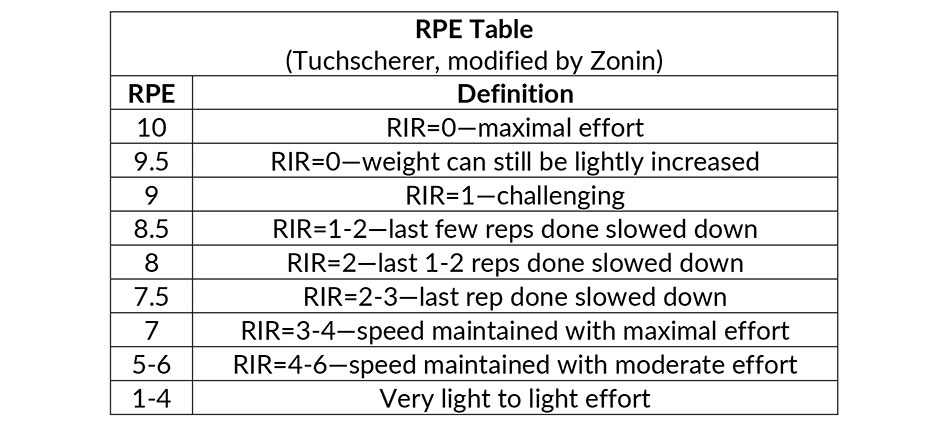
RIR Training vs. Training to Failure
In bodybuilding, it is a common practice to push sets until concentric failure, as it is a common belief that only the very last reps of a set—the most strenuous ones—are those that lead to results.
In strength training, on the other hand, it is common to train with a buffer and terminate a set before reaching failure.
In fact, most of the training volume is completed at a medium effort level (RPE=6-8 and RIR=4-2).
Only 5-10% of the volume is executed with a high effort (RPE>8.5-9 and RIR=2-1) and a maximal effort (RPE=9.5-10 and RIR=0). These are usually used only for testing 1RMs and attempting PRs, which is something that happens no more than 2-3 times a year.
A low effort (RPE<6 and RIR≥6) is used mostly for light/active recovery sets or sessions.
Some strength coaches prescribe interrupting the set before technique deteriorates and others stop the set as soon as the rep speed slows down.
Soviet weightlifting coaches used to prescribe a repetition range from 1/3 to 2/3 of the RM at a given weight.
At StrongFirst, we endorsed these guidelines.
But why do we want to stay away from failure? Let me explain using two different scenarios.
Let’s say your 6RM for the bench press is 225lb, this means you can do 6 reps at your maximum effort (RPE=10 and RIR=0).
Scenario 1—All-out sets
You load the bar at 225lb and do a set of 6 reps, pushing yourself to the very limit.
After a 2–3-minute rest, you try another set with the same weight, pushing until you can’t lift anymore. You likely won’t complete another full set of 6, perhaps reaching 4 reps.
If you keep doing all-out sets every 2-3 minutes, you will lose reps in each set. I can speculate that at the end of the game your rep count will progress along these lines: 6, 4, 2, 1.
Now, let’s consider a few things.
You did 4 sets and a total of 13 reps (6+4+2+1).
Consider the technique of these reps. For most athletes, I’d estimate only about 50%-60% were performed with perfect technique.
In the first set, you were probably able to maintain perfect technique for the first 4-5 reps.
In the second set, the first couple of reps were likely perfect. By the third set, perhaps only the first rep was perfect, and in the fourth, the single rep completed was probably not.
So, you did 7-8 perfect reps out of 13. As I mentioned, 50-60%.
In addition, I’m pretty sure that the next day, towards the evening, you will feel sore, and the muscle soreness will last for a few days, which means that you will not be able to train the bench press again for some time.
Scenario 2—Sets with RIR
If you load the bar with 225lb and do 3 reps—half of your RM—and then rest for 2-3 minutes, you should be able to hit another set of 3 reps.
I speculate that you can easily complete 6 sets of 3 reps, and most likely even more.
Let’s assume you did 6 sets, which means a total of 18 reps.
Now, let’s make our analysis.
I’m sure you agree that 90-100% of these reps were technically perfect.
In addition, you won’t be sore the days following your session, which means that you will be able to train the bench press again, even on the next day if your plan calls for it or you wish to do so.
The bottom line is that training with RIR allows you to complete a higher volume in a session, maintain perfect technique, and train more frequently, which in turn allows you to train with a higher weekly or monthly volume.
Guess what a higher volume with perfect technique leads to? More strength gains and most likely, more muscle growth.
Static Reps vs. Variable Reps
In addition to what was discussed above, we at StrongFirst advise varying the number of reps from set to set, staying within 1/3 to 2/3 of the RM, often using ladders as an effective tool to manage high volumes and combat neural and metabolic fatigue.
Let me explain why we do so with two different scenarios.
Let’s say that you loaded the bar with your 8RM weight, and your session calls for a total volume of 25 reps (NL=25). One-third and 2/3 of the RM rounded to the closest integers are 3 and 5, respectively, hence your rep range is 3-5.
Scenario 1—Static reps at the top of the range
You do 5 sets of 5, the well-known 5×5.
Scenario 2—Variable reps
You do the following ladder composed of 6 sets: 3, 5, 4, 5, 3, 5.
Now, let’s compare the two scenarios.
The ladder leads to a higher number of sets to totalize the prescribed volume. More sets lead to more set-ups, and the importance of practicing a perfect set-up as the first prerequisite for a perfect lift is well known.
With the ladder, even though the weight and volume are the same, only a few sets are pushed to the upper end of the rep range, allowing you to stay fresher throughout the session and maintain perfect technique.
Additionally, keeping the rep count static in the upper end of the rep range leads to more time under tension in each set, which leads to more muscle gains. Some fatigue will gradually build up throughout the session—but never to the point of leading to failure or compromising technique—and this teaches the lifter to struggle under high efforts, which is an important prerequisite for setting PRs.
The bottom line is that there are rationales that support both static reps at the top of the rep range and ladders, and this is why we use both according to several factors, including the athlete’s skill level and the goal of the plan.
The plan I’m about to share with you takes into consideration the principles and considerations above but applies them in an unconventional way. If you are ready to break your plateaus in strength and muscle gains, keep on reading.
The Triple-Tier Plan for Strength and Muscle Gains
I have explained why at StrongFirst we prescribe a rep-range according to the RM at a given weight and we usually vary the number of reps within that range. But while we usually do this from set to set within a session, this plan prescribes varying the reps from week to week within 3-week cycles.
The plan lasts 12 weeks and consists of two parts: a 9-week preparation phase followed by a 3-week peaking phase.
The preparation phase consists of three three-week blocks. During each block, you’ll keep the volume steady. However, the RPE will rise each week as you increase the reps per set and reduce the total number of sets.
When switching from one block to the next one, the RPE drops down, while the volume increases noticeably (≥20%).
The 3-week peaking phase foresees a sharp drop in the volume and a gradual decrease of RPE, with increased intensity towards the final testing week.
You may choose to apply this strategy to two to six lifts, according to your goals and the time you can devote to your training. In this article, I will show you how to design a three-lift plan.

Here’s how to design your Triple-Tier Plan, step by step.
Step 1—Select the lifts
Pick one lift for each one of the movement patterns and enter them into your weekly schedule.
Example:

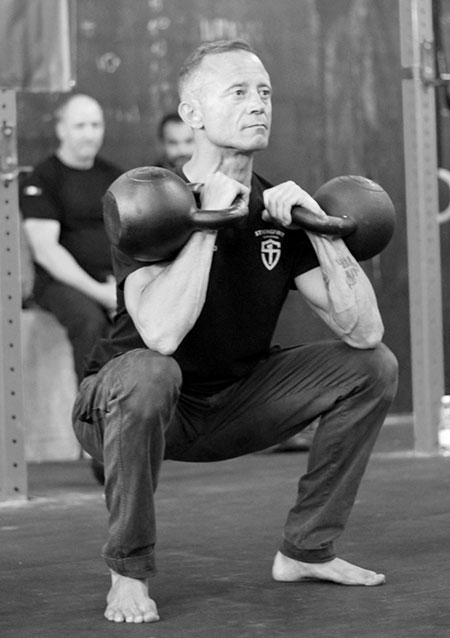
Step 2—Find your training weights
You will train each lift at three different intensities, heavy, medium, and light. To establish what is heavy, medium, and light, you will use specific RM ranges.
The table below outlines what heavy, medium, and light will be for you in terms of RM ranges.

According to the table above, you will select the following four weights for each lift:
- One weight that allows you to complete 1-3 perfect reps.
- One weight that allows you to complete 4-7 perfect reps.
- One weight that allows you to complete 8-11 perfect reps.
- One weight that allows you to complete 12-15 perfect reps.
Please take the time to test your exact RM with each weight, as it will be crucial for assigning the proper training parameters to your plan.
This plan relies on accurate rep counts based on your RMs. Guesswork could lead to miscalculations, rendering your sessions too light or too tough.
Hence, selecting the appropriate weights, and accurately testing your RMs, is your ground zero for this plan.
Example:
You can complete one perfect rep of double kettlebell military press with a pair of 36kg kettlebells and decide to test your RMs with a pair of 32s, 28s, and 24s. Below are your results:
- 36kg x 1RM
- 32kg x 4 reps
- 28kg x 8 reps
- 24kg x 15 reps
Step 3—Establish your rep counts
Once you have established your training weights and tested your RMs, use the table below to establish your rep count for each week and intensity for the preparation and the peaking phases.
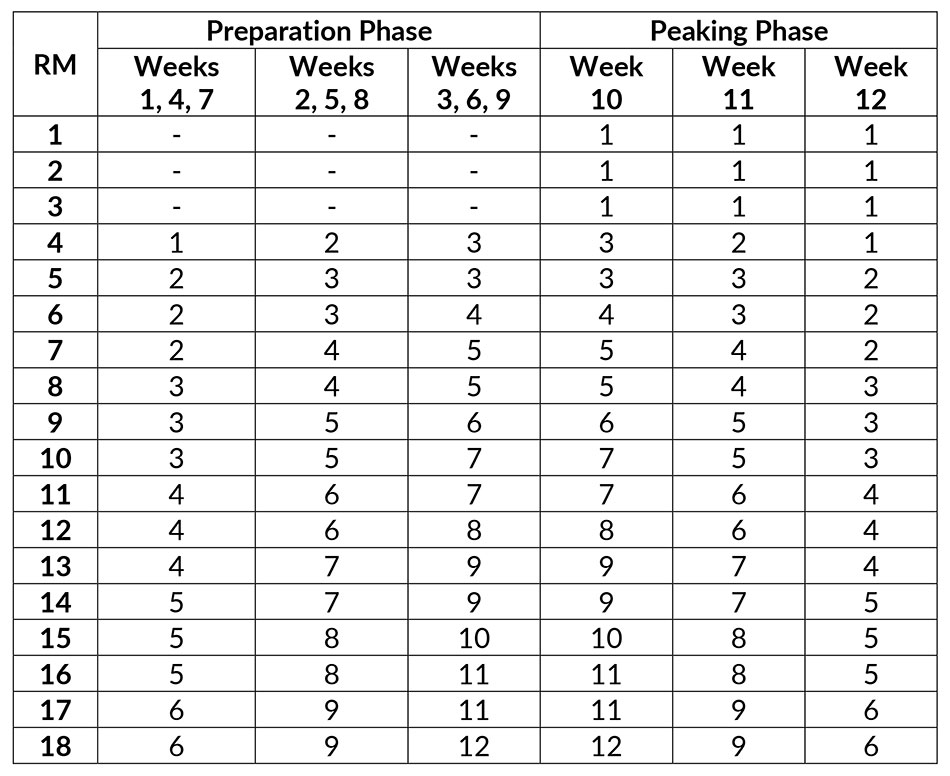
Example:
Let’s stick with the previous example of the double kettlebell military press. The rep counts are as follows:
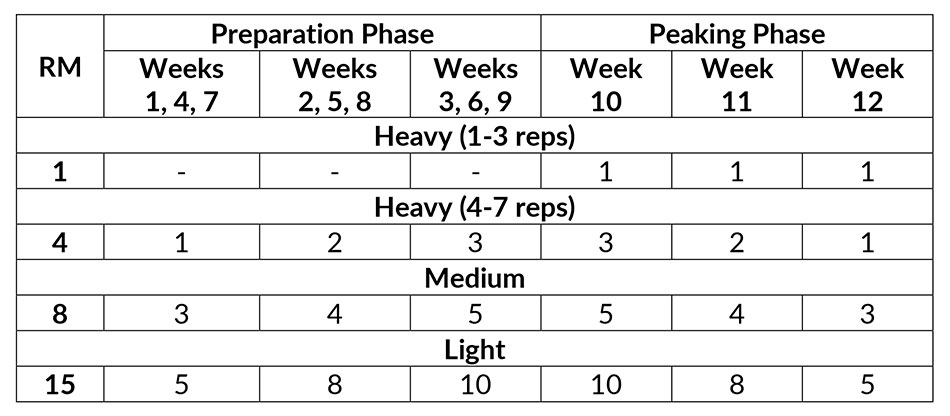
Step 4—Establish your progression
The table below illustrates the volume to be totalized each week per each intensity.

Now that you know your training weights, your rep counts, and the weekly volumes, you are in possession of all the elements you need to establish your progression. Let’s see how it works through two examples, the first covering the preparation phase and the second covering the peaking phase.
Example:
Once again, we will stick with the previous example of the double kettlebell military press. Let’s see how your training schedule looks like during the preparation phase.
Session A calls for your heavy day, and you will do the following:
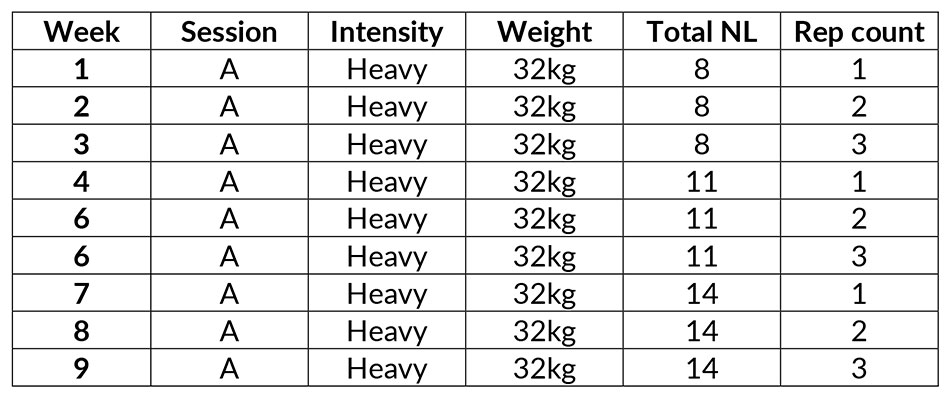
- On week 1 you will do 8 singles.
- On week 2 you will do 4 sets of 2 reps.
- On week 3 you will do 2 sets of 3 reps, followed by a double.
- On week 4 you will do 11 singles.
- …and so on and so forth.
Note that it will not always be possible to complete the prescribed volume with the prescribed rep count, and hence the very last set may have a lower rep count.
Session B calls for your light day, and you will do the following:
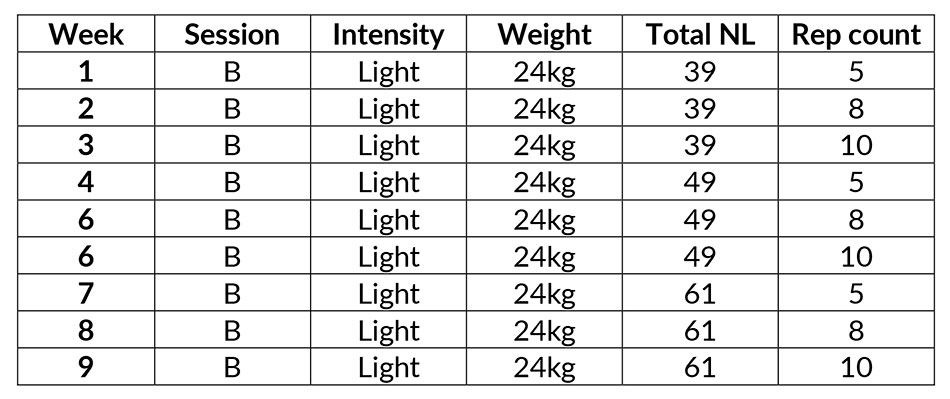
- On week 1 you will do 7 sets of 5 reps, followed by a set of 4 reps.
- On week 2 you will do 4 sets of 8 reps, followed by a set of 7 reps.
- On week 3 you will do 3 sets of 10 reps, followed by a set of 9 reps.
- On week 4 you will do 9 sets of 5 reps, followed by a set of 4 reps.
- …and so on and so forth.
Session C calls for your medium day, and you will do the following:
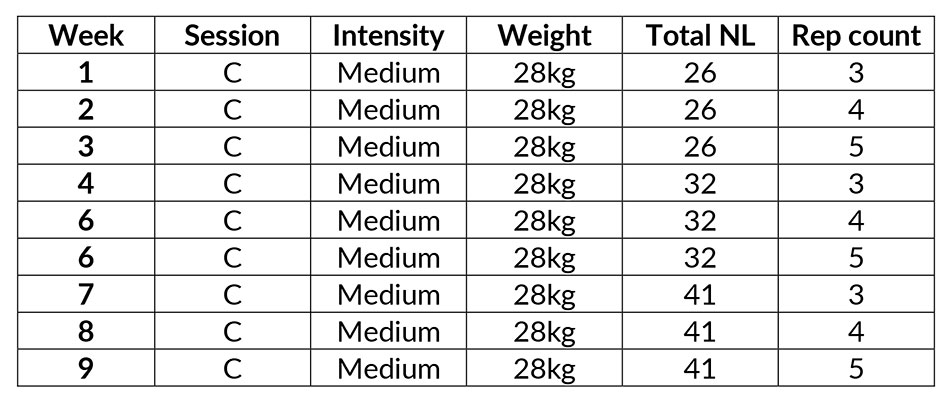
- On week 1 you will do 8 sets of 3 reps, followed by a double.
- On week 2 you will do 6 sets of 4 reps, followed by a double.
- On week 3 you will do 5 sets of 5 reps, followed by a single.
- On week 4 you will do 10 sets of 3 reps, followed by a double.
- …and so on and so forth.
As you can see, while in each 3-week block the volume remains constant, the RPE increases from week to week, together with the number of reps per set. Within the block the increase in the RPE is counterbalanced by a reduction of the number of sets.
The volume increases from block to block during the 9-week preparation phase.
Things change in the 3-week peaking phase in which the volume drops down dramatically compared to the previous block.
During this final block the volume remains mostly constant, while the RPE decreases from week to week, together with the number of reps per set. Also, some singles with the 1-3RM heavier weight are introduced.
The drop in volume and RPE, together with the increased average intensity induced by the introduction of the heavy singles, sets the foundation for a successful final test.
You have several options for the final test. You may either:
- Try to set a new 1RM/PR.
- Test your RM with the 1-3RM weight and assess its increase.
- A combination of 1 and 2. Once tested the 1RM, take a generous rest (ideally 10 minutes) and then test your RM with your 1-3RM weight.
Example:
Continuing to stick with the previous example, let’s see how your training schedule looks during the peaking phase.
Session A calls for your heavy day, and you will do the following:

- On week 10 you will do one triple with 32kg, one single with 36kg, and a double with 32kg.
- On week 11 you will do one double with 32kg, two singles with 36kg, and a double with 32kg.
- On week 12 you will do one double with 32kg, and then test your 1RM, RM, or both.
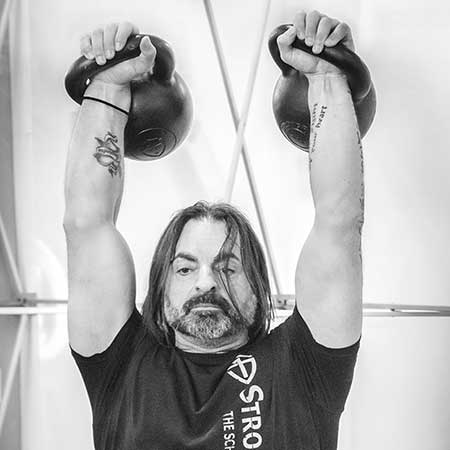
Note that the best strategy for this phase is to start your session with one set with the 4-7RM weight, then do the prescribed singles (or the test) with your 1-3RM weight, and finally switch back to the 4-7RM weight and do as many sets as necessary to complete the prescribed volume.
Session B calls for your light day, and you will do the following:

- On week 10 you will do 2 sets of 10 reps, followed by a set of 7 reps.
- On week 11 you will do 3 sets of 8 reps, followed by a set of 3 reps.
- On week 12 you will do 5 sets of 5 reps, followed by a set of 3 reps.
Session C calls for your medium day, and you will do the following:

- On week 10 you will do 3 sets of 5 reps, followed by a double.
- On week 11 you will do 4 sets of 4 reps, followed by a single.
- On week 12 you will do 5 sets of 3 reps, followed by a double.
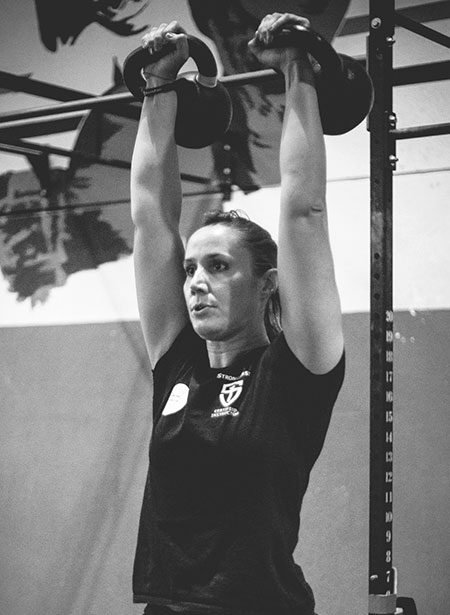
Conclusion
The Triple-Tier Plan emerged from my deep dive into research and practical trials to evolve our Plan Strong™ and Built Strong seminar curriculums. While this plan is distinct from our seminar offerings, it’s rich with pivotal insights—such as nuanced applications of RPE, RIR, and methods for modulating training intensity—that we’ll incorporate into our updated seminar materials.
You’ll also find new concepts such as Relative Effort and Average Relative Effort, along with innovative weekly training layouts.
I’m excited to invite you to join the upcoming Plan Strong™ and Built Strong seminars this April and May. It’s the perfect arena to familiarize yourself with these innovative strategies and apply them to achieve peak results for you and your students.
And for those of you who have been with us before, remember that the Loyal Alumni Price is there for you, offering a substantial 50% off as a thank you for your continued dedication.
I’m currently deep into the Triple-Tier Plan alongside my training partner, as well as the friends and colleagues who’ve enthusiastically participated in these “training experiments” of mine. Should you choose to embrace this plan and implement it with your students, I’m eager to hear about your experiences. Your feedback is not only welcome but invaluable—it’s the driving force that shapes our continuous improvement.
Power to you—and here’s to advancing together in strength and skill!
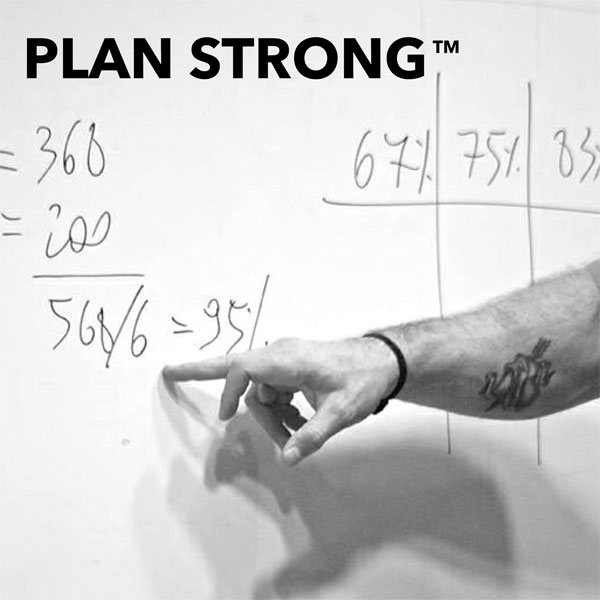

Don’t miss our online seminars with Fabio Zonin:
Plan Strong™—October 5-6, 2024
Built Strong—November 16-17, 2024






Hello Fabio! I have been reading all your articles for a long time and putting them into practice with my students. My question is this: If you include a Hinge like a deadlift in this plan, wouldn’t it be a good idea to lower the NL for that exercise somewhat? After all, traditionally, in the world of strength training, deadlifts use higher intensity and lower volume. For example, 61 repetitions in weeks 7-9 may be too hard for most, while for example in the bench press this NL is normal. And if you think reducing NL is a good idea, how exactly would you do it? Thank you!
Hello Fabio! I have been reading all your articles for a long time and putting them into practice with my students. My question is this: If you include a Hinge like a deadlift in this plan, wouldn’t it be a good idea to lower the NL for that exercise somewhat? After all, traditionally, in the world of strength training, deadlifts use higher intensity and lower volume. For example, 61 repetitions in weeks 7-9 may be too hard for most, while for example in the bench press this NL is normal. And if you think reducing NL is a good idea, how exactly would you do it? Thank you!
Hi Daniil,
Thank you for your trust in reading my articles and putting them into practice, Sir!
Even though the strategy at the foundations of this plan can be applied to other lifts including the deadlift, this specific plan was designed for a squat, an upper body press and an upper body pull.
It is true that traditionally deadlifts are trained with a lower volume compared to that of other lifts (I’m not sure about the higher intensity, as many athletes use a lower volume and also a lower intensity) and hence in case someone decides to add this lift to the schedule they may consider lowering its volume. That said, some lifters (e.g. me) can easily tolerate such volumes also in the deadlift. I just completed a Tripe-tier plan based on 6 lifts, including the deadlift, and I maintained the same volume all across the board. But again, this is very personal and the training volume in each lift should be adjusted to the individual.
Really interesting program, thanks for it! I wonder how to incorporate with deadlifts? Is it reasonable to combine it with your deadlift program from “Stop fearing heavy weights”?
Hi Martin,
You can actually incorporate the deadlift into your weekly schedule and use the same progression as for the other lifts. You can also substitute some exercises with others.
Below is an example of a weekly schedule that includes the hinge pattern:
Monday:
Heavy: Upper body press
Medium: Upper body pull
Light: Hinge
Tuesday:
Heavy: Squat
Medium: Hinge
Light: Upper body press
Thursday:
Heavy: Upper body pull
Medium: Upper body press
Light: Squat
Friday:
Heavy: Hinge
Medium: Squat
Light: Upper body pull
And here is the same example with some selected exercises (I chose barbell lifts to show how flexible this plan is):
Monday:
Heavy: Bench Press
Medium: Barbell Row
Light: Deadlift
Tuesday:
Heavy: Back Squat
Medium: Deadlift
Light: Bench Press
Thursday:
Heavy: Barbell Row
Medium: Bench Press
Light: Back Squat
Friday:
Heavy: Deadlift
Medium: Back Squat
Light: Barbell Row
I hope this helps. Let me know if you have any questions.
Read through the article a few times. My assumption this is a thrice a week schedule do to the h,l,m and a,b,c tables. Is this correct?
Also, if one were to do 6 movements as mentioned, would you implement the same movement patterns as “if it flies right” program? Ex. Horizontal and vertical push, horizontal and vertical pull, hinge, squat?
Hi J,
You are correct!
For instance, I’m now running the plan based on 6 lifts and I am testing with an unconventional (and tough) weekly schedule:
Monday:
Heavy: Horizontal press & Horizontal pull
Medium: Vertical press & Vertical pull
Light: Horizontal press & Horizontal pull
Tuesday:
Heavy: Squat
Medium: Hinge
Light: Squat
Thursday:
Heavy: Vertical press & Vertical pull
Medium: Horizontal press & Horizontal pull
Light: Vertical press & Vertical pull
Friday:
Heavy: Hinge
Medium: Squat
Light: Hinge
On Mondays and Thursdays I alternate one set of the horizontal press with one set of the horizontal pull and one set of the vertical press with one set of the vertical pull.
Thank you.
Also, have you been testing this type of schedule with any anti glycolitic training to maintain conditioning? Something like axe or the bjj swing protocol
Not specifically with AXE or the BJJ protocols for now, but I do use some king of AGT on alternate days. Of course, the main dish is the Triple Tier Plan, so the AGT practices are very conservative as far as for the volume and the weights I use.
Do rest times matter as long as the reps are good?
You don’t need to time your rest intervals; you can start a new set when you feel ready. However, it’s essential not to rush or shorten the rest intervals in any way.
Yes, but where did those numbers come from? Is that progression set or is there an algorithm to generate the weekly volume? I was able to follow the tables up until Step 4. I see how the table in Step 4 is applied, but I am also curious how the volumes were derived.
The plan I shared in the article follows a specific progression, and there’s definitely an algorithm guiding the numbers. I’d love to explain the process behind them, but it’s a bit too in-depth for a comment. Would you consider posting this question in the forum? That way, I can provide a detailed answer that will be beneficial for everyone interested in this topic. I appreciate your curiosity and willingness to learn!
Gladly.
Another fantastic article Fabio, thank you.
It gives further insights into the programming in the Knock ‘Em Dead, Built Strong Maximum and Victorious online products.
I had been planning to try the KED I programming for my barbell military press (alongside my next deadlift cycle) and this gives me more confidence that this might work well.
I look forward to trying the Triple Tier Plan soon.
Thank you 🙂
This looks great and I am excited to try. I am just a little confused about how we determine the total NL for each session.
The table in Step 4 details the session NL.
Exactly. The Total NL per week and intensity zone is outlined in the first table pf step #4.
Thank you for pointing Daniel in the right direction, Peter.